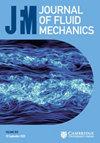Collision of liquid drops: bounce or merge?
IF 3.9
2区 工程技术
Q1 MECHANICS
引用次数: 0
Abstract
Whether colliding drops will merge with or bounce off each other is critical to numerous processes, and the physics involved is notoriously complex. In particular, experiments show that both sufficiently slow and fast head-on drop collisions lead to merging, but that there is often an intermediate regime in which bouncing is observed; these transitions in behaviour were recently discovered to be surprisingly sensitive to the radius of the drops and the ambient gas pressure. We show here that these transitions between bouncing and merging are governed by nanoscale phenomena; namely, gas-kinetic and disjoining pressure effects. To capture these crucial effects, a novel, open-source computational model is developed for the simulation of colliding drops. The model uses a hybrid approach, based on solving the Navier–Stokes equations in the drop with a lubrication approach for the unconventional physics of the gas film. Our simulations show remarkably good agreement with experiments of head-on collisions and also provide new experimentally verifiable predictions.液滴碰撞:反弹还是合并?
碰撞的液滴是相互融合还是相互弹开对许多过程都至关重要,而其中涉及的物理学也是出了名的复杂。特别是,实验表明,足够慢和足够快的液滴正面碰撞都会导致并合,但往往存在一个中间状态,即观察到反弹;最近发现,这些行为的转变对液滴半径和环境气体压力非常敏感。我们在此表明,弹跳与合并之间的这些转变受纳米级现象的支配,即气体动力学效应和脱节压力效应。为了捕捉这些关键效应,我们开发了一种用于模拟碰撞液滴的新型开源计算模型。该模型采用混合方法,基于液滴中的纳维-斯托克斯方程求解,并针对气膜的非常规物理特性采用润滑方法。我们的模拟结果与正面碰撞的实验结果非常吻合,同时还提供了新的可通过实验验证的预测结果。
本文章由计算机程序翻译,如有差异,请以英文原文为准。
求助全文
约1分钟内获得全文
求助全文
来源期刊
CiteScore
6.50
自引率
27.00%
发文量
945
审稿时长
5.1 months
期刊介绍:
Journal of Fluid Mechanics is the leading international journal in the field and is essential reading for all those concerned with developments in fluid mechanics. It publishes authoritative articles covering theoretical, computational and experimental investigations of all aspects of the mechanics of fluids. Each issue contains papers on both the fundamental aspects of fluid mechanics, and their applications to other fields such as aeronautics, astrophysics, biology, chemical and mechanical engineering, hydraulics, meteorology, oceanography, geology, acoustics and combustion.

 求助内容:
求助内容: 应助结果提醒方式:
应助结果提醒方式:


